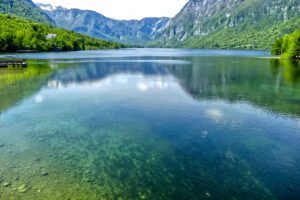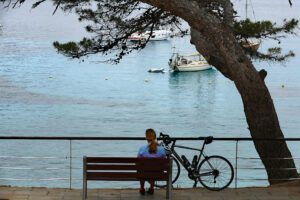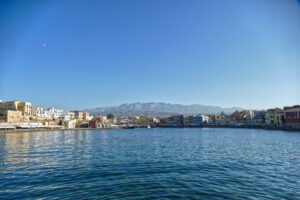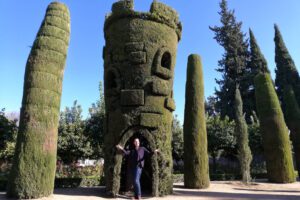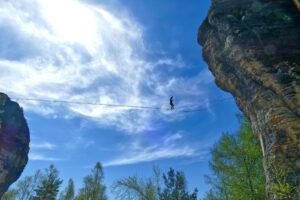After having spent a fantastic day underneath, on top, and between the magnificent walls of Tisá, I cannot fathom why this breathtaking labyrinth of towering sandstone formations amid the Bohemian Switzerland is such a hidden treasure. After all, it is perfect for hikers, climbers, and, obviously, even tightrope walkers!

The dramatic shapes of the sandstone steles that time has colored a mysterious black, and the winding paths feel like stepping into a fairytale world. Easily accessible and less crowded than other spots, they offer stunning views and an almost otherworldly atmosphere.
Tisá
Tisá’s origins date back to Schenau Castle. In the 16th century, the Bünau family founded the town of Schönstein on the lands of the former Schenau. Between 1554 and 1557, Günther von Bünau commissioned a castle in Schönstein. Also, a Protestant church, a school, and, of course, a brewery were added. During the Thirty Years’ War, however, Croatian troops burned Schönstein and Tisá. The same year, the Swedes plundered what remained of both towns. Schönstein was never rebuilt. In fact, its lands simply became part of Tisá.
In the mid-18th century, several button factories were established around Tisá. Nevertheless, today, the village’s economy relies primarily on tourism.

No wonder, because as you drive through the village, you will immediately be struck by the massive rock massif that forms a long wall towering over the town. But that’s just the tip of the iceberg Sandstone mountain. Inside the walls area, over a hundred impressive rock formations are waiting for you to explore.
The Rocks of Tisá
Captivated by the enchanting beauty of Děčín, the Czech border town where we spent part of our Easter holidays, we were looking for more. Faster, higher, but not necessarily further. It was quickly settled: even on public holidays, the buses that connect Děčín with the surrounding towns run at least every hour. Higher was also easily solved: we should go to Tisá. On the northeastern side of this inconspicuous village, majestic walls rise into the sky like burnt logs. These 30-meter-high rocks consist of sandstone, a material that turns black over time. Therefore, the area looks as if Gulliver’s giant hut had burned down. And that’s by far not the only feature that makes the area seem like a fairytale land.

The Tiské stěny, hence Tisá Walls, are at an altitude of 613 meters above the village of Tisá. Over tens of millions of years, the landscape has changed into an area of rock walls, cracks, columns, and canyons. With their peaks rising up to 70 meters, these rocks are one of the most remarkable natural attractions in Central Europe.

Since the 19th century, hikers, cyclists, and most importantly, climbers have started to enjoy this piece of earthly paradise.
An Amazing Maze
The rock labyrinth covers an area of approximately 100 hectares. It is divided into two large parts: the Great Walls and the Little Walls. Comfortable, well-signposted hiking trails lead through both areas. This way, not only ambitious climbers and trekkers find their Dorado between the massive stelae. The hikes are also perfect for families, even with smaller kids. And if the little ones do get tired, the imaginative names given to the rock formations will cheer them up again. They have to recognize mushrooms, turtles, lions, elephants, and much more in the bizarre shapes.

(Photo: Mimi Green)
There are two pre-designed trails that both start at the entrance above Tisá’s iconic St. Anna’s Church. There you’ll find a wooden hut where you pay your entrance fee and get information. You can also purchase some smaller souvenirs. About 1.5 kilometers further east is another entrance to the premises. Starting your walk here is only advisable if you come to Tisá in your own car and if you intend to walk the entire trail of the Great Walls.
But first, let me introduce the so-called Little Walls.
Little Walls
Hiking the circular trail of the Little Walls, you’ll get into the denser and more labyrinthine area. This path is narrower and takes you through a variety of crevices, caves, and tight passages. It’s like an adventure in an enchanted labyrinth. The dense rock formations definitely create a magical atmosphere. There are no distinctive viewpoints here like on the crest of the Great Tyssa Walls, but it is the proximity to the impressive rocks and the opportunity to move through small crevices and crevices that make this hike so special.

Nineteen rock formations await visitors on this circuit. A marked path from the entrance leads to Janus’ Head, where the route divides. The circuit heads to a rock gorge, which climbs to the West Lookout with a view of the towers of the Great Walls and the surroundings.

The path follows through the gorge and continues past the Confessional to the Forest Gate, the Pulpit, and the Stone Table. Then, Hercules, the Monster Cave, the Proviantura cave, the Swedish Cam,p and the Castle massif appear, which can be climbed by descending the stairs or more conveniently bypassing it at the foot.

(Photo: Mimi Green)
I found the small circuit more alluring and captivating. Keep in mind, however, that it’s considerably more difficult to complete. While the large circuit consists almost exclusively of straight forest paths, the small circuit involves climbing over hill and dale in many spots. It’s absolutely doable, but it requires a bit more stamina. However, the last bit is a comfortable path that takes you back to the main entrance.
Great Walls
The Great Walls’ circular route is actually the main hike. In total, it is three kilometers long and starts and ends at either one of the ticket offices.
It takes you through impressive rock formations, which often rise over 30 meters high and have bewitching shapes and intriguing structures. Every now and then, you’ll get to viewpoints from where you can overlook the breathtaking landscape.

There are fewer formations to admire on the crest of the rocks, but from here you can see the entire rocky landscape from above.
The Great Walls impress not only with their size, but also with their variety of formations. Over time, erosion has created true works of art: rock walls with deep holes and caves, gigantic towers and stones that seem to have faces. These bizarre rocks were often given names like turtle or Napoleon’s boots. With all due respect, we couldn’t identify any of the shapes named on the trail map, except for the elephant, which made us wonder what made it an Indian species. However, it’s just as fun to look closely and perhaps recognize something completely different in the fantastic structures of the stones.

The circular route finally leads you back to the ticket office, from where you can continue on to the second part of the hike.

Among other formations, there is also the slightly mischievous Test of Slimness, where many visitors try to stretch themselves through it. The route continues through a turn. Its base is narrower than the summit and is a touchstone for climbers. At the end, the path along the foot of the rocks leads to an iron staircase ascending to a rocky ridge. Then the path ends at the Tourist Hut, where there is a second entrance to the rocks.
From Wall to Wall
The connection of the two circular routes enables hikers to experience the entire beauty of the walls in one extended tour. After you have completed the Great Walls’ circular route, return to the ticket office and follow the signs to the entrance to the Little Walls. Here, you continue your journey of discovery on the small circular path and dive even deeper into the fascinating rock labyrinth.

(Photo: Mimi Green)
The combination of the two circular routes offers a comprehensive experience of this extraordinary landscape. You will admire the majestic rock formations of the Great Walls, which offer impressive views, while exploring the intimate and hidden areas of the Little Walls, which invite exploration and discovery.
Practical Information
How to Get There
The nearest major cities are Dresden on the German side of the Elbe Sandstone Mountains and the Czech capital, Prague. Both cities are about one to one and a half hours away by train from the town of Děčín. Trains run several times an hour in both directions.

From Děčín, you can easily and quickly get to Tisá by public bus. The buses are extremely reliable and very affordable. A trip from Děčín to Tisá costs 44 crowns, which is just 1.75 €uros, respectively 2 US$. First, you need to take bus #432 from Děčín to Libouchec, from where you continue to Tisá by bus #471. You can easily check all connections on Google Maps.
Plan Your Visit
The Tisá Walls are open all year round from 9 a.m. to 5 p.m.. The general admission is as little as 50 CZK, kids pay half price. Note that payment is possible only in cash, however, they also accept €uros. We paid 2.25 €uros each.
I’d say a trip to the walls is suitable for almost everyone: Athletes can really let off steam here, but even those with limited mobility can easily navigate at least the relatively straight forest paths of the large circuit. Even small children who are at least somewhat accustomed to walking will definitely manage the route. During our visit, we met many families with children. Everyone seemed to be having a good time, and not a single child complained. I wouldn’t go with a stroller, though, as you’d definitely have to carry it in some places.

When visiting the rocks, you need sturdy shoes with good soles. Especially after some rain, the rocks can be very slippery. If you can, make sure to choose a sunny day for your visit.
When we paid our entrance fee at the ticket office, we were given an extremely useful and informative map, which proved to be a perfect guide.
It contains detailed information about the various distinctive rock formations. All rocks are marked with unique numbers and corresponding descriptions.
My Tip
Aside from plenty of drinking water, it’s worth packing a small picnic. There are plenty of benches, large rocks, and patches of grass around the site where you can relax with a snack and rest for a while before continuing your hike.

Visiting Organized
Getting to the Tisá Walls from Děčín is still fairly easy, even by public transport. However, if you’re traveling further afield, it’s certainly recommended to join an organized day tour. It will get you there safely and back on time. Here are some tours to choose from*:
Where to Stay
If you plan on going to Tisá for longer than just one day to allow yourself to explore this amazing place, you can choose from a couple of accommodations in the very center as well as on the outskirts on this map*:
What to Eat
Czech cuisine is hearty, comforting, and deeply rooted in traditional flavors. There are lots of roasted meats, rich sauces, dumplings, and warming soups.
In general, Czech staples include my absolute favorite, the so-called Svíčková, pot roast beef in a creamy vegetable sauce with dumplings. You might also like to try Czech-style goulash and so-called bramboráky, crispy potato pancakes. Also, don’t miss out on fruit-filled dumplings or koláče for dessert. The latter are sweet dough topped with poppy seeds, jam, or curd.
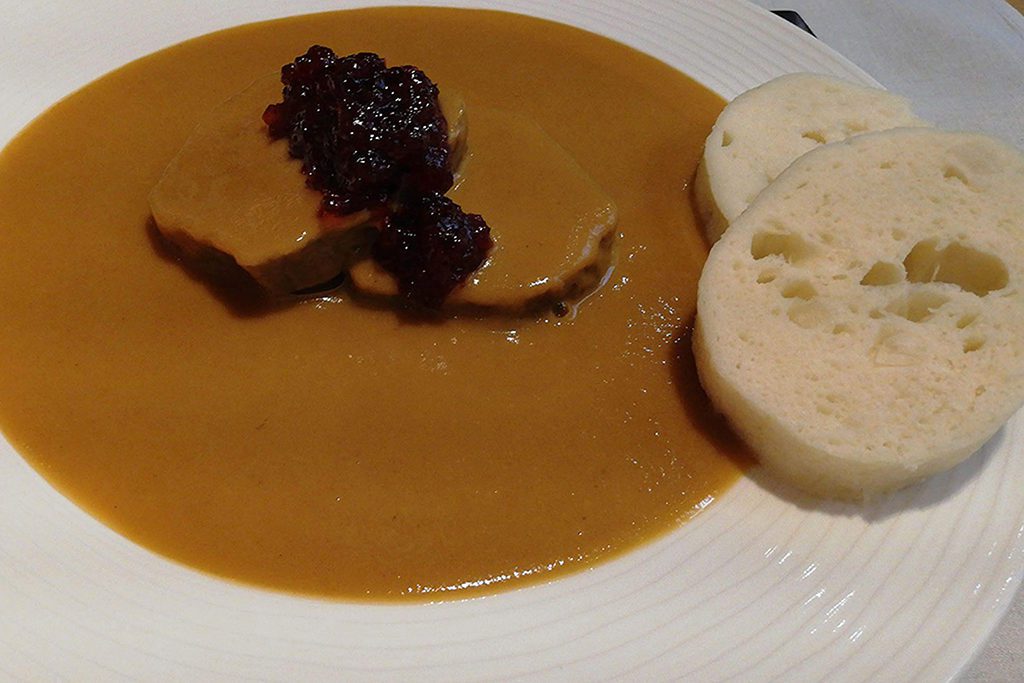
In Bohemian Switzerland, the food reflects this rustic charm. It often features game meats like venison or wild boar, fresh mushrooms from the surrounding forests, and trout from local streams. The region also embraces seasonal ingredients: wild berries in summer, root vegetables in winter.

Overall, Czech cuisine in Bohemian Switzerland is about simple, satisfying dishes made from local produce, offering an authentic taste of the country’s rural heart.
However, I can’t help but point out that vegetarians and vegans won’t really get their money’s worth here. Czech cuisine is generally lacking in vegetables. While salad plates are still reasonably tasty, all the vegetarian dishes Mimi ordered were just so-so. Czech gastronomy frankly has some catching up to do in this regard.
Cash And Cards
Prices in the Czech Republic are generally lower than in Germany, for example, especially when it comes to traditional restaurants, public transport, and entrance fees. Although the Czech Republic has been a member of the European Union since 2004, they do not pay with €uros.

As of May 2025, the exchange rate is 21.94 CZK to one USD, respectively 25 CZK to one €uro. You can check the current rate on this page. Credit cards and contactless payments are accepted almost everywhere, including on buses. And if you actually do have to pay in cash, you can usually do so easily in €uros.
Language
Czech is an extremely complicated language, both in terms of grammar and, above all, pronunciation. Especially here in the border region with Germany, and due to tourism from the neighboring country, older people tend to speak reasonably good German, while the younger generation is fluent in English.
Since Czech is a Slavic language, those familiar with any other tongue from this family should be able to understand a tiny bit and read many of the signs or writings on goods.
In this guide, I’m writing out some of the Czech names of places, and you will notice that there are accents that might not exist in other languages.
First of all, c is never ever pronounced k! It is pronounced like the ts in Tsar. So it’s Vatslav, neither Vaklav nor Vatchlav.
Only when c is written č, it is pronounced like a ch: Děčín or Česká pošta, Czech Post Office.
The Post Office is also a good example of the letter s. Written š, it’s pronounced sh. But only then.
People tend to overdo it with the ch and the sh. It’s so simple: if there is no accent, it’s a simple c or s, no crackjaw there.
You’ll notice a ´ on many vowels. This tells you to elongate that vowel, like, for instance, in far. So in Tisá, the second vowel is long and the first one is short: Tesah.
I’ll leave it at these few examples and explanations, because all the rules of pronunciation alone would easily take up an entire post. As I said, most people speak a second language and will be happy to try to understand which Czech word you are butchering.
Pinnable Pictures
If you choose to pin this post for later, please use one of these pictures:






Did You Enjoy This Post? Then You Might Also Like These:
A Day Trip to Lake Bohinj – Where Slovenia is Beautiful And Wild
Baroque Splendor And River Romance: The Must-Sees of DRESDEN
From PORT d’ANDRATX to SANT ELM – Hike With a View
Best Things to Do in CRETE in One Week
Guide to CORDOBA – the Moorish Center of Andalusia
The Island of IOS During Off-Season
Büdelsdorf Revisited – bye:myself at the NordArt 2018
Best Day Trip in the Bohemian Switzerland: The Magnificent Walls of Tisá
* This is an affiliate link. Hence, if you book through this page, not only do you get the best deal. I also get a small commission that helps me run this blog. Thank you so much for supporting me!
